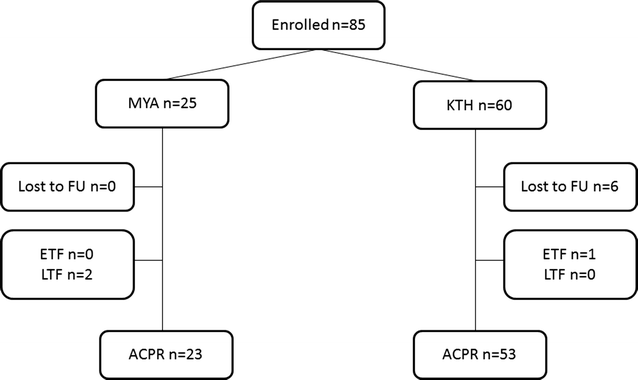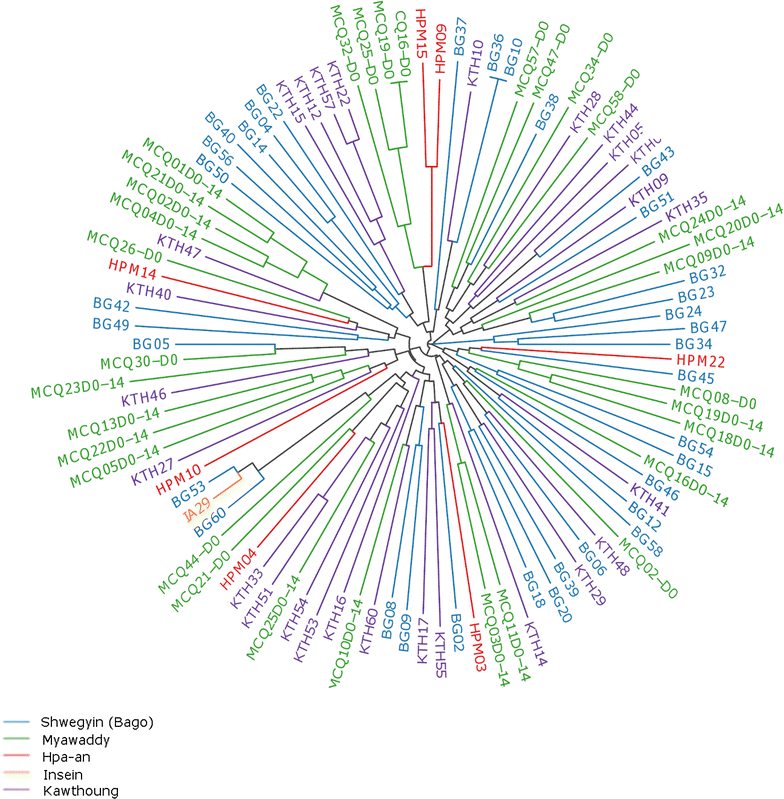Chloroquine efficacy for Plasmodium vivax in Myanmar in populations with high genetic diversity and moderate parasite gene flow
- PMID: 28693552
- PMCID: PMC5504659
- DOI: 10.1186/s12936-017-1912-y
Chloroquine efficacy for Plasmodium vivax in Myanmar in populations with high genetic diversity and moderate parasite gene flow
Abstract
Background: Plasmodium vivax malaria remains a major public health burden in Myanmar. Resistance to chloroquine (CQ), the first-line treatment for P. vivax, has been reported in the country and has potential to undermine local control efforts.
Methods: Patients over 6 years of age with uncomplicated P. vivax mono-infection were enrolled into clinical efficacy studies in Myawaddy in 2014 and Kawthoung in 2012. Study participants received a standard dose of CQ (25 mg/kg over 3 days) followed by weekly review until day 28. Pvmdr1 copy number (CN) and microsatellite diversity were assessed on samples from the patients enrolled in the clinical study and additional cross-sectional surveys undertaken in Myawaddy and Shwegyin in 2012.
Results: A total of 85 patients were enrolled in the CQ clinical studies, 25 in Myawaddy and 60 in Kawthoung. One patient in Myawaddy (1.2%) had an early treatment failure and two patients (2.3%) in Kawthoung presented with late treatment failures on day 28. The day 28 efficacy was 92.0% (95% CI 71.6-97.9) in Myawaddy and 98.3% (95% CI 88.7-99.8) in Kawthoung. By day 2, 92.2% (23/25) in Myawaddy and 85.0% (51/60) in Kawthoung were aparasitaemic. Genotyping and pvmdr1 CN assessment was undertaken on 43, 52 and 46 clinical isolates from Myawaddy, Kawthoung and Shwegyin respectively. Pvmdr1 amplification was observed in 3.2% (1/31) of isolates in Myawaddy, 0% (0/49) in Kawthoung and 2.5% (1/40) in Shwegyin. Diversity was high in all sites (H E 0.855-0.876), with low inter-population differentiation (F ST 0.016-0.026, P < 0.05).
Conclusions: Treatment failures after chloroquine were observed following chloroquine monotherapy, with pvmdr1 amplification present in both Myawaddy and Shwegyin. The results emphasize the importance of ongoing P. vivax drug resistance surveillance in Myanmar, particularly given the potential connectivity between parasite population at different sites.
Keywords: Chloroquine; Copy number; Diversity; Efficacy; Genotyping; Malaria; Myanmar; Plasmodium; Resistance; Transmission; Vivax; pvmdr1.
Figures




Similar articles
-
Chloroquine efficacy studies confirm drug susceptibility of Plasmodium vivax in Chennai, India.Malar J. 2014 Mar 31;13:129. doi: 10.1186/1475-2875-13-129. Malar J. 2014. PMID: 24685286 Free PMC article.
-
Ex vivo susceptibilities of Plasmodium vivax isolates from the China-Myanmar border to antimalarial drugs and association with polymorphisms in Pvmdr1 and Pvcrt-o genes.PLoS Negl Trop Dis. 2020 Jun 12;14(6):e0008255. doi: 10.1371/journal.pntd.0008255. eCollection 2020 Jun. PLoS Negl Trop Dis. 2020. PMID: 32530913 Free PMC article.
-
Plasmodium vivax resistance to chloroquine in Madagascar: clinical efficacy and polymorphisms in pvmdr1 and pvcrt-o genes.Antimicrob Agents Chemother. 2008 Dec;52(12):4233-40. doi: 10.1128/AAC.00578-08. Epub 2008 Sep 22. Antimicrob Agents Chemother. 2008. PMID: 18809933 Free PMC article.
-
Evolution of the Plasmodium vivax multidrug resistance 1 gene in the Greater Mekong Subregion during malaria elimination.Parasit Vectors. 2020 Feb 12;13(1):67. doi: 10.1186/s13071-020-3934-5. Parasit Vectors. 2020. PMID: 32051017 Free PMC article.
-
Chloroquine resistance is associated to multi-copy pvcrt-o gene in Plasmodium vivax malaria in the Brazilian Amazon.Malar J. 2018 Jul 16;17(1):267. doi: 10.1186/s12936-018-2411-5. Malar J. 2018. PMID: 30012145 Free PMC article.
Cited by
-
Efficacy of directly-observed chloroquine-primaquine treatment for uncomplicated acute Plasmodium vivax malaria in northeast Myanmar: A prospective open-label efficacy trial.Travel Med Infect Dis. 2020 Jul-Aug;36:101499. doi: 10.1016/j.tmaid.2019.101499. Epub 2019 Oct 8. Travel Med Infect Dis. 2020. PMID: 31604130 Free PMC article. Clinical Trial.
-
Special Issue: "Parasitic Infection and Host Immunity": Editorial.Microorganisms. 2023 Apr 14;11(4):1027. doi: 10.3390/microorganisms11041027. Microorganisms. 2023. PMID: 37110450 Free PMC article.
-
Multidisciplinary Investigations of Sustained Malaria Transmission in the Greater Mekong Subregion.Am J Trop Med Hyg. 2022 Oct 11;107(4_Suppl):138-151. doi: 10.4269/ajtmh.21-1267. Print 2022 Oct 11. Am J Trop Med Hyg. 2022. PMID: 36228909 Free PMC article.
-
Molecular Surveillance and Ex Vivo Drug Susceptibilities of Plasmodium vivax Isolates From the China-Myanmar Border.Front Cell Infect Microbiol. 2021 Nov 1;11:738075. doi: 10.3389/fcimb.2021.738075. eCollection 2021. Front Cell Infect Microbiol. 2021. PMID: 34790586 Free PMC article.
-
The changing epidemiology of Plasmodium vivax: Insights from conventional and novel surveillance tools.PLoS Med. 2021 Apr 23;18(4):e1003560. doi: 10.1371/journal.pmed.1003560. eCollection 2021 Apr. PLoS Med. 2021. PMID: 33891580 Free PMC article. Review.
References
-
- WHO . World malaria report 2016. Geneva: World Health Organization; 2016.
-
- Delacollette C, D’Souza C, Christophel E, Thimasarn K, Abdur R, Bell D, et al. Malaria trends and challenges in the Greater Mekong Subregion. Southeast Asian J Trop Med Public Health. 2009;40:674–691. - PubMed
Publication types
MeSH terms
Substances
Grants and funding
LinkOut - more resources
Full Text Sources
Other Literature Sources

